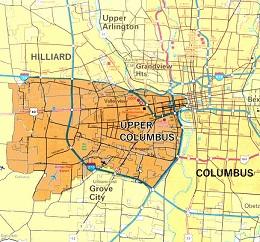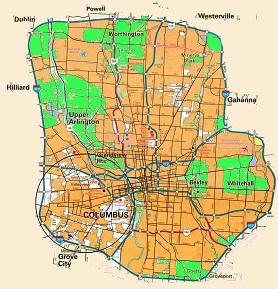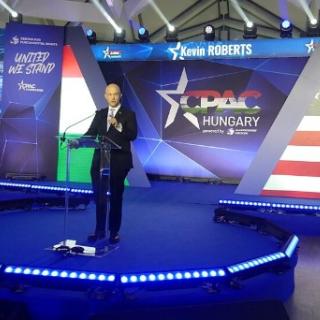Advertisement
The lands west of downtown Columbus have only had one robust economy since mayor George Meeker first annexed Franklinton and a couple square miles up Sullivant's Hill in 1870. Meeker also renamed Sullivant's Hill (where prosperous Franklinton people had built large luxurious homes, above the floodplain, overlooking the city), "The Hilltop." However, Mayor Meeker (who was involved in east and north side land developers), annexed the Westside in a way that would prevent it from ever taking another "highly desirable" private building project away from the other sides of his city.
How did he do this?
When he annexed the Westside, he used eminent domain to have both the city and state buy all of West Columbus’s premium land (I mean every inch above the Franklinton floodplain) for two enormous government projects. See both here
One would even be the largest building on earth from 1877-1942, but it was also something very few people wanted to see or be near unless they were into horror.
So even if Meeker’s enormous Lunatic and Imbecile Asylums (the official terms) could not scare off potential upscale Westside developers, they could only buy land in West Columbus land becomes a lake every few years, because that was all of the that Mayor Meeker left available for his brand new side of town.
Besides Hawkes Hospital (now "Mt. Carmel West", which is closing), large private employers avoided West Columbus for the next 75 years.
FYI: As soon as Mayor Meeker had his Asylum plans signed off, after barely 1 year in office, he left his mayorship to open a law firm, and enter state politics, featuring the development of land east and north of Columbus.
So who caused West Columbus only robust economy?
At the end of World War II, Mayor James A. Rhodes (future Ohio governor), promised enough Westside infrastructure and annexation to persuade General Motors and Westinghouse into opening several large (10,000 worker) factories on top of the Sullivant's old hill, finally opening the Westside's political hidden economic potential.
Rhodes just wanted to improve the Westside's constantly struggling economy, even though he spent almost no time in the area. He likely could have easily talked them into to developing lands where Columbus already had the infrastructure, but apparently, he didn't even try.
By the mid-1950s, his efforts had caused this highland side of his “academic city”, to become the economic envy of Central Ohio, and its economy boomed until the mid-70's.
However, in 1955 a new mayor, M.E. Sensenbrenner realized the immense financial power the city's new income taxes provided, as did many mayors in other large American cities at that time. So suddenly they began offering huge incentives to legally bribe large employers to open or expand into their cities.
It appears that Sensenbrenner wanted far more as he went on an annexation rampage nabbing virtually every underdeveloped "No City" site within 10 miles of city hall. However, he did not annex another inch of the underdeveloped commercial/industrial sites only west-southwest of city hall, even if barely 1 mile away.
Look at the big white holes in this map. By not calling most of the underdeveloped lands only on this side of town "Columbus", he and future mayor's could not pay incentives for land not on city spreadsheets, even if it is 100% surrounded by land that is on them.
Sensenbrenner (intentionally or unintentionally) reactivated Meekers' old plan to keep as many large employers and "desirable" projects as possible, on the other sides of town.
So the Westside has only replaced 4 of its 20 largest 1974 private employers, and these four are far smaller. Of those four, Express Scripts is gone, BIG LOTS just moved 800 of its Westside workers away, the Casino is legally anchored here, and the Walmart store is so far to the southwest it mainly serves the Grove City area.
FYI: The only large private employer to open in West Columbus this century (over 500 employees) is the Hollywood casino. However, the only reason it came to West Columbus, city leaders took their developers to court to prevent a casino from opening on their sides of town.
The casino has been a wonderful addition, and the only economically exciting development to happen on Sullivant's old hill this decade. It is not the Casino’s fault they only brought in 800 jobs to the same address that General Motors once employed 10,000.
When we don’t pay attention, ugly history just repeats
Today as three sides of Columbus are greatly expanding from today’s booming economy, the Westside continues collapsing from the mid-1970s recession because no one ever exposed these (and other) obvious political avoidance plans on the westside’s economy.
So today instead of enjoying Columbus’s huge economic progress, Westside places like Copper Stadium, Westland Mall, the 3 million square foot Sears Distribution Center, and dozens of large lesser know Westside sites just keep rotting away.
It is very hard to fix bad problems before they are exposed, and this town exposes very few, which explains why:
Columbus has likely moved into 1st place!
In 2015, local scholars, newspapers, and leaders tried to explain why Columbus has the second largest disparity between low and high incomes of all large U.S cities.
But none pointed out how city spreadsheets have kept the Westside out of the city’s negotiations with upscale developers for 6 decades, which would naturally cause this huge disparity.
Once you tack on the huge recent Westside job losses since 2015, Mt. Carmel West (most of 2000), BIG LOTS (800) and Express Scripts (450), by ignoring its Westside Columbus has likely taken that #1 spot away from Austin Texas.
Misrepresentation:
Thousands of voters who live on these "No City" sites, totally surrounded by Columbus, do not even cast a vote for which Columbus candidates will be ignoring them next.
The root cause of this problem is that just this side of Columbus has almost never had political or economic representation that lives in it or even cares to be in it, so an entire side of a large American city has no economic defenders or protectors.
West Columbus may be the only complete side of a large American city that has no local political or chamber of commerce representation, that shows they even care about its economy.
Leave a comment if you know of the Columbus Chamber ever helping to bring even one large private employer to West Columbus, as I could not find one ever. I could only determine that their Vice president, who is also a Columbus Chamber VP, helped BIG LOTS move their Westside HQ away, to get them over $20 million in Columbus tax concessions.
My conclusion is that the area I now call Upper Columbus will never be able to compete for great new upcoming developments against the rest of Central Ohio until it has its own government and business leaders making damn sure this area is at least in the conversations for large "desirable" Central Ohio projects.
I will be spending the next months building a team of volunteers to help to establish the new Upper Columbus Chamber of Commerce, and I (the westside) could use all the help in this area you can offer.
If you want to help build this long overdue Upper Columbus Chamber, contact me, Westside Craig, at Craig@UpperColumbus.com.





